Grow Heirloom Seeds From Monticello And Mount Vernon


Presidents' Day can be more than a day off school for the kids. It's the perfect time to teach our children about the impact our Founding Fathers had on agriculture. Even if a day trip to Mount Vernon or Monticello is not in the picture, growing a pack of George Washington or Thomas Jefferson heirloom seeds is a great way to spark interest in both gardening and American history.
Growing Monticello Seeds
For more than 50 years, Thomas Jefferson called Monticello home. Located outside of Charlottesville, Virginia, Monticello is now a National Historic Landmark. Owned by the Thomas Jefferson Foundation, Inc., the house, grounds and plantation have been restored to how they looked when Thomas Jefferson was alive.
If you're looking for some of the same plants grown by Thomas Jefferson, consider these beautiful Monticello flower seeds:
- Bachelor's Button -- (Centaurea cyanus) Also known as cornflower, the striking blue flowers of this annual average 1.5 inches (4 cm.) in diameter.
- Blackberry Lily -- (Iris domestica) The six-petaled, red-spotted, orange flowers can rise up 4 feet (1.2 m.) from the clump of spear-like foliage.
- China Pink -- (Dianthus chinensis) Jefferson used these fringed-petaled flowers as a border for his winding flowerbeds. Dianthus is a biennial which is usually grown as an annual.
- Eastern Red Columbine -- (Aquilegia canadensis) A North American native, Eastern Red Columbine has beautiful red and yellow flowers with upward spurred petals.
- Mexican Prickly Poppy -- (Argemone mexicana) Looking very much like a type of thistle, the Mexican Prickly Poppy has deeply lobes leaves with prickles.The bright yellow flowers measure approximately 2.5 inches (6.3 cm.) across.
Flowers aren't the only plants gracing the acreage of Monticello. A variety of vegetables were grown in Thomas Jefferson's era. Try planting these interesting Monticello heirloom seeds:
- Florence Fennel -- (Foeniculum vulgare azoricum) This bulb-forming type of fennel has a rich anise flavor with a crunchy texture like celery. Jefferson's Florence Fennel seeds came from Italy by Thomas Appleton in 1824.
- Lacinato Kale -- (Brassica oleracea var. acephala cv.) This Italian heirloom variety of kale graced Jefferson's vegetable garden in 1777. Lacinato has a more delicate flavor and is less bitter than curly leaf varieties.
- West Indian Gherkins -- (Cucumis anguria) Recommended by Thomas Jefferson to his brother in 1813, these bite-sized gherkins have all the flavor of cucumbers without any of the bitterness.
- Zatta di Massa Melon -- (Cucumis melo cv.) In 1774, Jefferson planted 18 hills of these deeply ribbed, ancient melons. The extremely sweet flesh has a brilliant orange color.
Growing Mount Vernon Seeds
It's no wonder Mount Vernon is one of America's most visited historic homes. In addition to George and Martha Washington's stately mansion, the house is surrounded by four gardens hosting plant collections from around the world. Consider growing some of these same flowers and vegetables which graced the gardens of our first president:
- Boston Marrow Squash -- (Cucurbita maxima “Boston Marrow”) It's no wonder this large hubbard-type heirloom was the most popular squash variety for over 100 years. The bright orange flesh earned Boston Marrow Squash the title of “true pie squash” by seeds salesmen of the era.
- Broom corn -- (Sorghum vulgare) In colonial times, the coarse, fibrous seed head of this sorghum was used to make brooms. Give this heirloom plenty of overhead room as the Broom corn plant can reach heights of 10 to 18 feet (3-5.5 m.).
- Fish peppers -- (Capsicum annuum) The variegated immature fruit and foliage make Fish peppers an interesting specimen in the vegetable garden. This medium-hot chili cultivar has historical significance in African-American cuisine.
- Love-Lies-Bleeding -- (Amaranthus caudatus) An unusual cottage-type flower with cascading crimson flowers, Love-Lies-Bleeding blooms from July through frost.
- Mangelwurzel -- (Beta vulgaris 'Mangelwurzel') With roots more than a foot long, this variety of beets was used as animal fodder in colonial times. Harvested at smaller sizes, Mangelwurzels can be added to soups or served mashed with butter. George Washington grew this heirloom in 1788.
- Silver Standard Tulip -- (Tulipa 'Silver Standard') Although it can take six years for this tulip to bloom when planted from seeds, the gorgeous red and white streaked flowers of the Silver Standard tulip are worth the wait.
Gardening tips, videos, info and more delivered right to your inbox!
Sign up for the Gardening Know How newsletter today and receive a free copy of our e-book "How to Grow Delicious Tomatoes".

Laura Miller has been gardening all her life. Holding a degree in Biology, Nutrition, and Agriculture, Laura's area of expertise is vegetables, herbs, and all things edible. She lives in Ohio.
-
 Terrifically Tubular Flowers For Hummingbirds: 9 Tube-Flowered Plants To Attract Hummers
Terrifically Tubular Flowers For Hummingbirds: 9 Tube-Flowered Plants To Attract HummersGrowing tubular flowers for hummingbirds helps you create the optimum feeding conditions for your winged friends. Here are nine tubed delights for hummers
By Tonya Barnett
-
 How To Grow Hydroponic Tomatoes For Fresh Indoor Harvests – No Soil Required
How To Grow Hydroponic Tomatoes For Fresh Indoor Harvests – No Soil RequiredLearning how to grow tomatoes in water is easy and allows you to harvest fresh-home-grown produce in every season without any mess.
By Ellen Wells